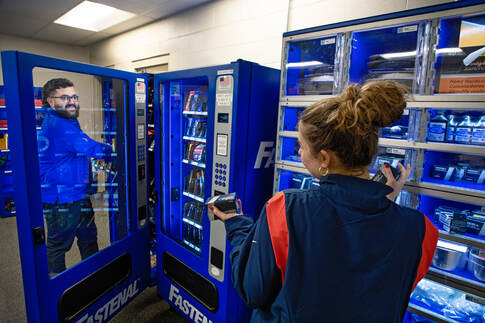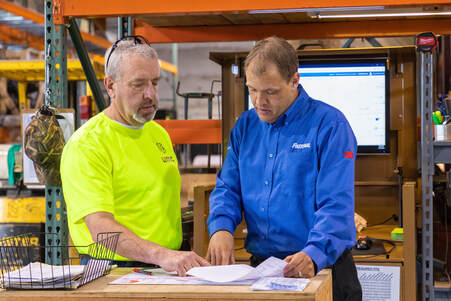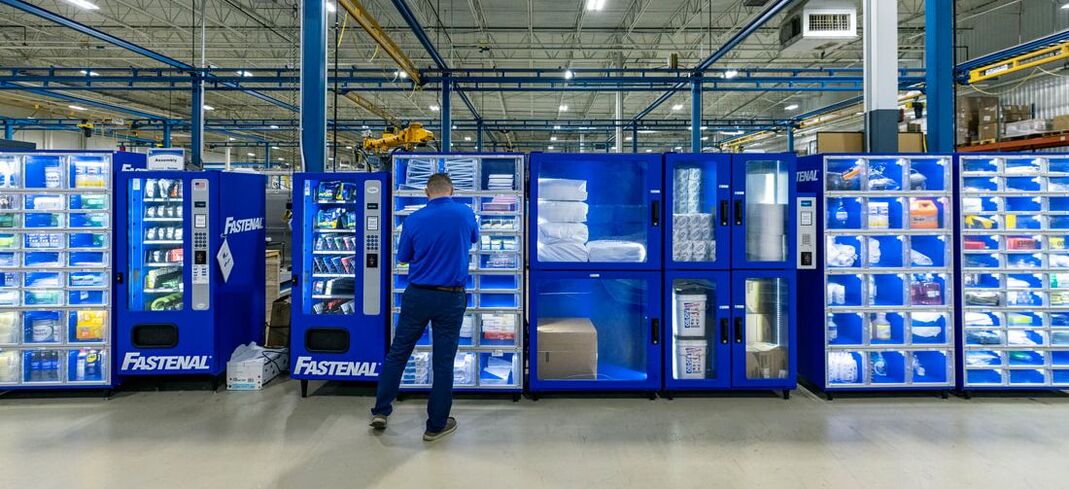What we learned after installing our 100,000th vending machine
February 7, 2024
By Ben Johnson | Three decades in supply chain
By Ben Johnson | Three decades in supply chain
|
A wise boxer once said, "Everybody has a plan until they get punched in the mouth."
Well, supply chains are going to throw the occasional haymaker. Maybe you can avoid a few, but eventually, one's gonna land. How you react is what matters. That's why supply chain management is important. So, after helping thousands of teams with their supply chains, here are four questions answered. Why vending machines?
The primary benefit of inventory technology (vending, lockers, etc.) is that products are right where employees need them. Pair that with an automated restocking system and you’re making your supply chain stronger.
How it works: Whenever an employee takes an item and that action brings the inventory below a preset minimum, the system is designed to automatically signal for more stock. The need is digitally communicated to the supplier to fulfill the order. What this means for you is that the entire process of delivering products to the point of use is automated. An alternative scenario: An employee finds a low-stock situation, takes time to notify someone, and a purchase request is started. This traditional method involves a complex and costly process of placing orders, often with multiple suppliers, consuming significant procurement effort and resources. It’s worth noting that using technology in your supply chain means you’ll consolidate a lot of purchases with a single supplier. Some folks prefer the flexibility of sourcing parts from various suppliers, even though it adds complexity. That’s their prerogative. If I were a purchasing manager, though, I’d prefer not to have my team spend time on this. With a contract in place ensuring fair pricing at market value, there’s no need to waste hours trying to save small amounts on individual parts through price negotiations. The focus should be on efficiency and simplification of the procurement process. There’s also this to consider: If your supplier relationships are purely transactional, what motivation do those suppliers have to secure and improve your supply chain? Even if they were so inclined, would they have the data and visibility needed to plan effectively and provide relevant solutions? A transactional mindset can preclude strategic collaboration. When will supply chain issues be resolved?
Stopping supply chain troubles hinges on two things: 1. enhanced planning and 2. predictive analysis. Unsurprisingly, those are both core elements of inventory management technology.
One of the first things you appreciate about inventory technology is how extensive the data collection can be. Then, you begin to realize that (because each machine is reporting its own unique usage) you’re not getting just the 10,000-foot-view. No, you’re actually seeing where specific products are (and are not) being used. This wealth of data lets you home in on the ideal inventory levels for each location. The more information gathered, the more adept the forecasting is for what’s to come. This is the crux of supply chain management – anticipating the future. Now, this isn’t a perfect science. Stockouts aren’t 100% a thing of the past. But by amassing more and more data, supply chain technology can help illuminate trends, improve planning, and power future innovations. The world is currently in the early phases of Industry 4.0. Someday AI will be as integrated in our work and home lives as the internet. But without substantial and accurate data, AI is ineffective (or even counterproductive). So, even as it addresses today’s problems, inventory technology sets a foundation for tomorrow’s possibilities. In the here and now, the goal is very simple: collect as much data as possible while refining our understanding of minimum and maximum inventory logic (i.e., how much to stock) at each product location. OK, that’s not the simplest goal out there, but you get the idea. More data equals greater future success. Where are the supply chain problems?
Hint: it’s not necessarily a remote country or shipping lane. The pandemic conditioned us to think of supply chain problems on a global scale. However, more often than anyone cares to admit, the problems are stemming from within the facility, aka “the last quarter-mile” of the supply chain.
Sure, there are distribution bottlenecks. And parts can be backordered because of manufacturing delays. But sometimes the issue is simply that the product is stuck in the receiving department or lost in inefficient inventory storage. That’s why visibility within the last quarter-mile is so important. Even when the parts are available and people are receiving them in properly, companies often lack clear visibility and data on part usage. Questions like who is using the parts, where they are going, or how they are being allocated to cost centers or specific projects remain unanswered. This lack of understanding handcuffs demand forecasting because teams don’t have a clear picture of where their products are being used. They end up purchasing products only when they run out, without the ability to forecast needs accurately. Capturing the right data can improve this situation. By knowing which departments and projects are using which parts, companies can do a better job of forecasting. The challenge lies in collecting that data and accounting for product expenses. And the answer can be inventory technology – because vending machines and lockers offer precisely this kind of data. Why get a supply chain partner?A coworker of mine recently said, “Our job is to find what’s valuable to other people and guide them to the best result.” So, if I have to boil down the role of a true strategic partner, it’s just that.
You don’t need someone who’s only useful when it benefits them or when you place an order. You need someone who’s thinking about how to make your world better even when you’re not asking them to.
Not every item is suited for vending machine distribution. The supplier should be ready with other methods like bin stocking programs for less frequently needed maintenance items. Plus, there are now newer technologies like RFID and IR bin systems for items that move quickly in both MRO and OEM categories. So, the answer to “Do I need a supply chain partner?” is yes. BUT you need a partner who is responsibly matching your needs and goals with their strengths. You may also like:Vertical Divider
|
Inventory + Vending = ValueWith more than a billion items vended in 25 countries around the world, I can say with confidence that inventory vending creates value.
Vendor-managed inventory can helpIf you ever thought about authoring “Supply Chains for Dummies,” you’re too late. (Search that on Amazon and you’ll get over 400 hits!) Needless to say, supply chains are complex.
Perfect really is the enemy of goodIf you Google “How supply chain management works,” you’ll get a LOT of results. Not all of them would make sense for your situation though. And you don’t have time to waste trying different things.
That’s why it’s wise to find a partner who’s already learned the lessons and can apply the fixes directly to your situation. Experience matters. Find a partner who can bring the best ideas in the marketplace. Then give them a low-risk opportunity to start earning your trust. Like what you're seeing here? Subscribe to the Blue Print for FREE and get the magazine sent right to your address.
|






